INTRODUCTION
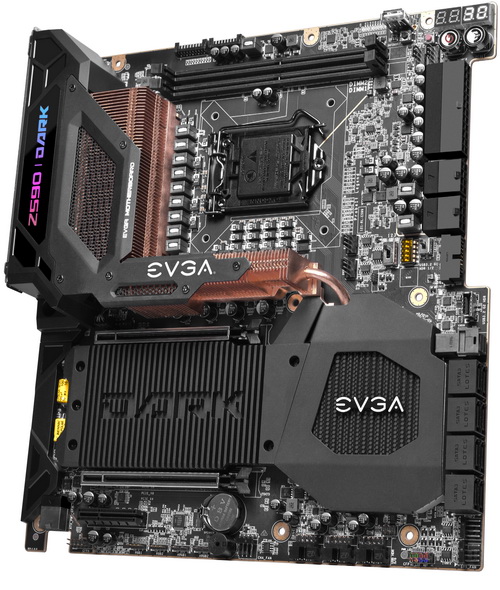
It’s been many years since I’ve seen AMD and Intel compete so fiercely in the consumer CPU market but this is exactly what’s been happening for roughly 2-3 years now. The latest example is no other than the 11th generation Core CPUs by Intel and the Ryzen 5 series by AMD. AMD currently holds the multi-core performance crown (5900X/5950X) but Intel still holds single-core performance crown (11900K) so consumers are basically asked to decide based on usage (and motherboard features). Because of that I decided to start testing as many Intel Z590 and AMD B550/X570 motherboards possible to showcase exactly what you can expect in terms of not only performance but also motherboard features. Well today marks the beginning of those reviews/tests with one of the most popular motherboards for overclockers currently in the market, the Z590 DARK by EVGA.
EVGA is the #1 NVIDIA authorised partner in channel sales throughout North America and UK. Based on the philosophy of intelligent innovation, market knowledge, and the real time operation, EVGA continues to identify the need in the market place and providing the solution to that need. By offering product differentiation, a 90 day Step-Up programme, and other customer focused programmes, EVGA is a clear leader in all categories: etail, retail, distribution, and system integration. With headquarters in Brea, CA, EVGA's global coverage includes EVGA GmbH in Munich, EVGA LATAM in Miami, and EVGA Hong Kong.
Unlike both the Z390 and Z490 DARK models EVGA used a different design for their newest Z590 DARK motherboard, a more aggressive and industrial look design. Now as many of you already know the socket type (LGA 1200) remains the same (meaning it’s still compatible with LGA 115x coolers) as with the Z490 and you can still use both 10th and 11th generation Intel CPUs but the Z590 brings something we all wanted from the Z490, PCIe Gen 4.0 for both the PCIe slots (graphics cards) and for at least one of the M.2 slots (SSDs). On the other hand, supported JEDEC RAM speeds have not increased (still the Z590 does support higher RAM OC speeds) but with the arrival of DDR5 this means it will not be long before we see motherboards with such compatibility. The Z590 DARK also sports an impressive 21-phase digital VRM, dual DIMM slots (dual-channel configuration – 64GB total supported with speeds exceeding 5333MHz), 100% copper heatsink with twin fans, two full-length EMI shielded (and reinforced) PCIe 4.0 slots (x16/x8-8), onboard ARGB LEDs, single PCIe 3.0 x4 slot, three M.2 SSD slots (1 Gen4x4 & 2 Gen 3x4 - these share bandwidth with the U.2 port and the PCIe 3.0 x4 slot), six native Intel SATA 6Gb/s ports (support RAID 0/1/5/10), two ASMedia (ASM1061) SATA 6.0Gb/s ports, single U.2 NVMe port, dual probelt connectors, two ARGB and two RGB connectors and right angled ports for both power and SATA. Needless to say, EVGA has once again equipped their DARK motherboard with a large number of innovative features aimed towards overclockers including PCIe disable switches (allow the end user to disable PCIe slots for troubleshooting), CPU slow-mode switch (can be used to change the CPU ratio on-the-fly to minimum), safeboot button (boots directly into the BIOS without changing your settings - handy if your system will not boot with those settings), , multi-function indicators, and the triple-bios selection switch. Rear connectivity has actually changed quite a bit between models so here we see a full sized DisplayPort v1.4 port, HDMI v2.0 port, six USB 2.0 ports (via 3 internal headers), 4 intel USB 3.2 Gen1 Type-A ports (2 external & 2 internal), 6 USB 3.2 Gen 2 ports (4 Type-A, 1 Type-C, 1 Type-C internal header), two Intel i225V 2.5 GbE (10/100/1000/2500) Ethernet ports, AX201 Dual-Band WiFi 6/BT 5.1 (2x2 antenna based), NU Audio amplifier (for stereo speakers and headphones/headsets) and the Realtek ALC1220 High Definition Audio onboard audio card. So, let’s see what the flagship motherboard in the current EVGA lineup is capable off.
SPECIFICATIONS AND FEATURES

PACKAGING AND CONTENTS
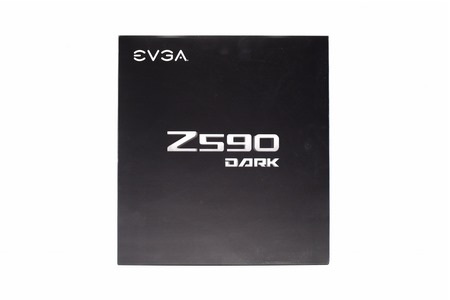
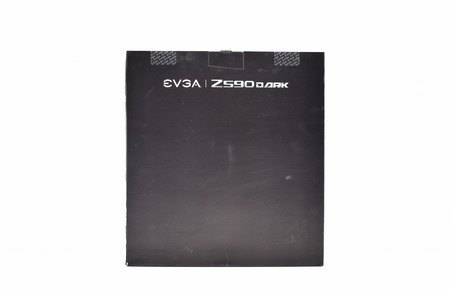 Faithful to their previous models EVGA once again packs their latest DARK model inside a black box that just has their logo and the model name at both the front and rear.
Faithful to their previous models EVGA once again packs their latest DARK model inside a black box that just has their logo and the model name at both the front and rear.
The box is also black inside and as you can see the motherboard is placed right between to black pieces of foam (the rest of the bundle is placed inside an accessory kit box).
EVGA once again offers the most complete bundle I’ve seen with an Z590 motherboard so inside the box you will find a full size virtual guide (made out of thick plastic), dual WiFi Antenna, four SATA 6Gb/s Cables, two probelt voltage measurement connectors, three M.2 Thermal Pads, three M.2 screws, motherboard mounting screws, 10 very tall standoffs, plastic case badge, compact USB flash drive (contains the initial drivers) and the installation guide.
THE Z590 DARK
The brand new Z590 DARK just might be the best looking motherboard I’ve seen for a very long time.
Thanks to both its 21-phase digital VRM design and its 100% copper heatsink with the two fans inside (40mm ones?) it should be very easy to hit 5GHz+ with the 11900K which I’ll be using for this review.
The dual DIMM design may not make everyone happy (64GB total) but it also helps with overclocking and system stability.
Once again on the top left corner we find two LED post indicators safeboot (black) button, clear CMOS (red button), two CPU PWM fan headers, dedicated USB port for BIOS flashing, and the power on/off and reset buttons.
Further down we find the PCIe disable switches, slow-mode switch and the BIOS selection switch right next to the angled power ports.
The G2, U2 and SATA data connectors are all placed right next to each other on the lower right of the motherboard.
The internal USB headers are located on the lower end of the motherboard right next to the onboard speaker and the extra 6-pin PCIe power connector (according to EVGA this connector provides dedicated power to the PCIe x16 slots, augmenting the +12V power provided by the 24-pin and the GPU directly).
The Realtek ALC1220 onboard audio card is located just next to the rear I/O right next to the NU Audio amps.
Unfortunately, the Z590 DARK has just two full-length EMI shielded (and reinforced) PCIe 4.0 slots (x16/x8-8) and a single PCIe 3.0 x4 slot which shares bandwidth with the 3rd M.2 slot (meaning you can only use one of the two).
Moving at the rear I/O we find a PS/2 connector, two USB 3.2 Gen1 ports, two Antenna connectors, reset CMOS button, four USB 3.2 Gen2 ports, single USB 3.2 Gen2 Type-C port, two 2.5GbE Ethernet ports, DisplayPort v1.4, HDMI v2.0 and the 5.1 analog/digital audio output.
The model name is printed on the other side of the PCB (i was hoping for a backplate).
The full size plastic guide is something only EVGA offers (to my knowledge) and it's extremely useful when building or tweaking your system.
Also worth pointing out is that the Z590 DARK is the very first motherboard by EVGA (haven't checked the FTW model which was released a few months earlier) to feature onboard ARGB lighting (alas somewhat limited).
With the Intel I9-11900K, ACER PREDATOR APOLLO 32GB 4GHz CL17 modules and Sabrent Rocket 4.0 Plus 4TB SSD now mounted (among other things) the Z590 DARK is ready to boot.
Z590 DARK V1.05 BIOS
The BIOS tabs have remained almost the same since the Z490 DARK so once again from the main screen you can choose between loading preset and automatic overclocks (Gamer Mode and OC Robot), load the default settings or enter the BIOS and adjust things on your own.
The BIOS has a total of 6 tabs and as with previous models almost everything related to overclocking is placed under the OC Tab. Here you can change the multiplier, set the BCLK frequency and of course adjust every voltage you could ever want to or have the need for (as with my Z390 and Z490 reviews for all Z590 tests the I9-11900K will be set at 5GHz with a RING ratio of 47).
As always from the Memory tab you can use one of the available XMP profiles, set the frequency, adjust voltages and of course you can also adjust the timings.
Under the Advanced tab you can access the various CPU technologies, check information on the CPU and of course adjust everything else related to the mainboard and all the included peripherals such as the audio card, LAN and fans (EVGA has added resizable BAR support as well).
Of course, as always you can adjust the time and date and all the various boot options from the Boot tab.
Inside the save and exit tab you can save your BIOS settings into various profiles, override the boot sequence and restart the system.
Under the extras menu you can find a very convenient CPU stress test, automatic overclock feature, several OC profiles by KINGPIN and Luumi and the BIOS update option.
ELEET X1 SOFTWARE
If you'd like to skip entering BIOS you can overclock your system using the ELEET X1 software by EVGA.
As you can all see here you have almost every CPU overclock setting available in the BIOS, just slightly easier and faster to navigate.
The same of course applies to the RAM since you can also tweak timings from within the ELEET X1.
Typically, the software also has a health monitoring tool available, information on the system and lighting adjustment for both the onboard and ARGB/RGB headers (9 effects).
There’s also a WiFi tab which for some reason wasn’t very stable (system would be connected wirelessly but many times this tab would not reflect that).
TESTING METHODOLOGY
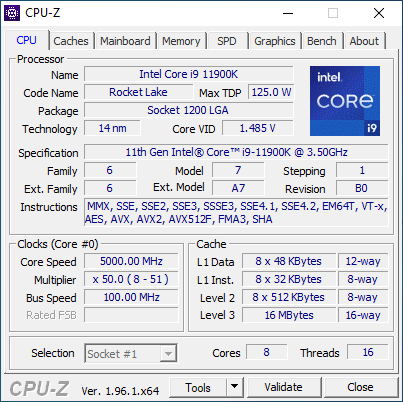
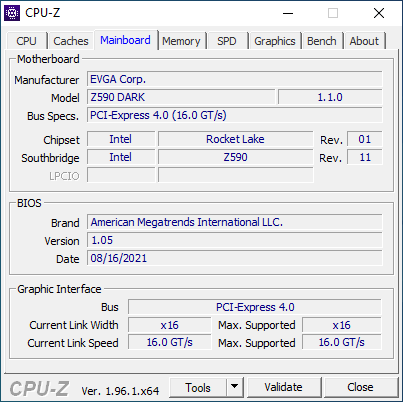
Exactly like used to do in the past each mainboard to arrive in the lab will get mounted on an open-air test bench and will be used for no less than two full weeks (daily tasks and gaming) with a fresh Windows 10 Pro installation. All motherboards arriving here will be tested with the top CPU of that line available at the time of each review (I9-9900K for Z390/I9-10900K for Z490/I9-11900K for Z590) together with 16GB (2x8GB) DDR4 4GHz RAM for the Z390/Z490 motherboards and 32GB (2x16GB) DDR4 4GHz RAM for the Z590 motherboards. Now I don’t know if I will need to change this anytime soon but for now all CPUs will be set at 5000MHZ (CPU ratio set to 50 - of course voltages may vary slightly from motherboard to motherboard) with their RING/Cache frequency at 4700MHZ (ratio set to 47).
I did think about pushing each motherboard to the max to see which is the better overclocker but 5GHZ 24/7 is more than plenty today, not only in terms of performance but also temperatures (not to mention there are colleagues of mine who have been focusing on maximum overclock potential). Instead i decided that it'd be far more interesting (not to mention accurate) to see which motherboard is the fastest when using the same exact hardware components/configuration (CPU/RAM/COOLER) with the same exact overclocking frequencies *. To figure that out I’ll be using several benchmarking programs (6 repeats after which the average numbers will get recorded in the charts) like AIDA64, CINEBENCH R20, CPUZ, Passmark Performance Test, RealBench and the Sisoftware Sandra Titanium 2020 version. Needless to say, that between different system configurations these charts also do a great job pointing out the difference in CPU performance.
* Charts will contain other system configurations as well in order to better showcase the performance of each reviewed system.
TEST RESULTS - AIDA64 / CINEBENCH R20


TEST RESULTS - CPUZ / PASSMARK PERFORMANCE TEST
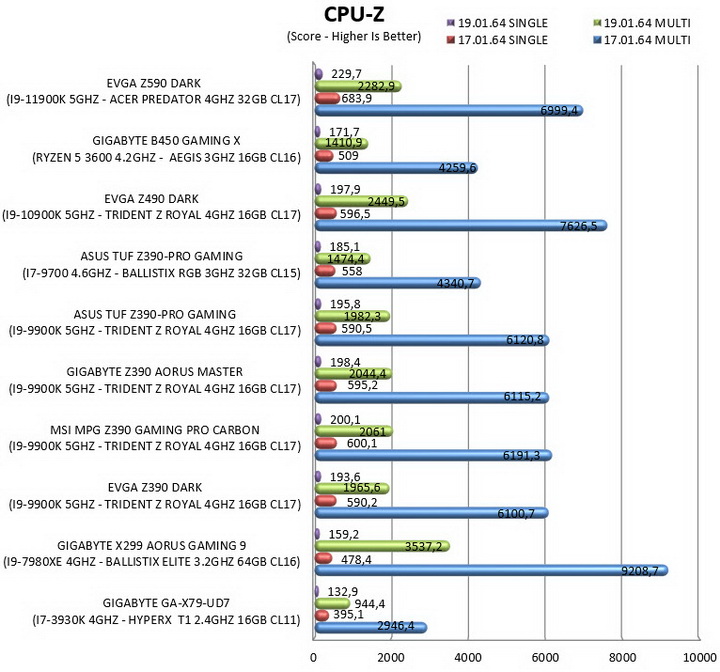
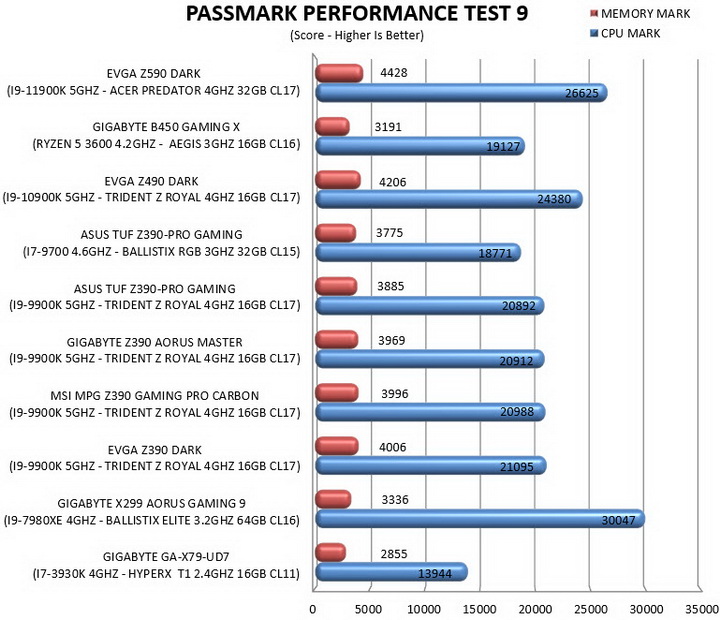
TEST RESULTS - REALBENCH / SISOFTWARE SANDRA TITANIUM 2020
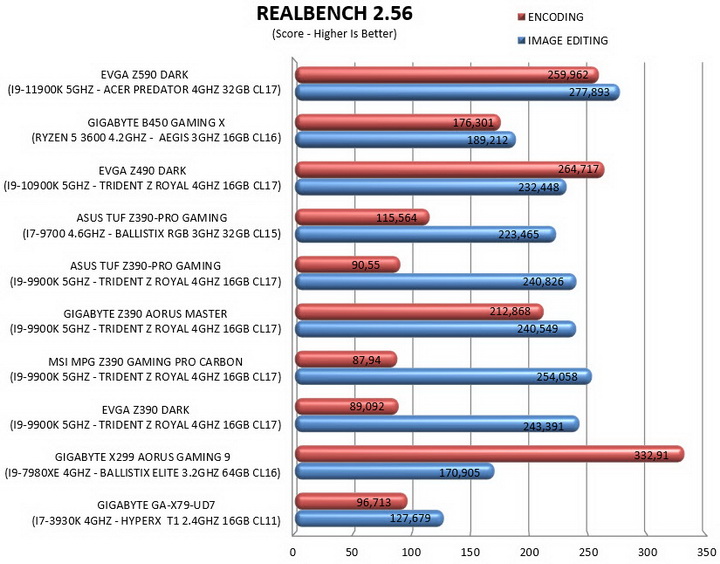
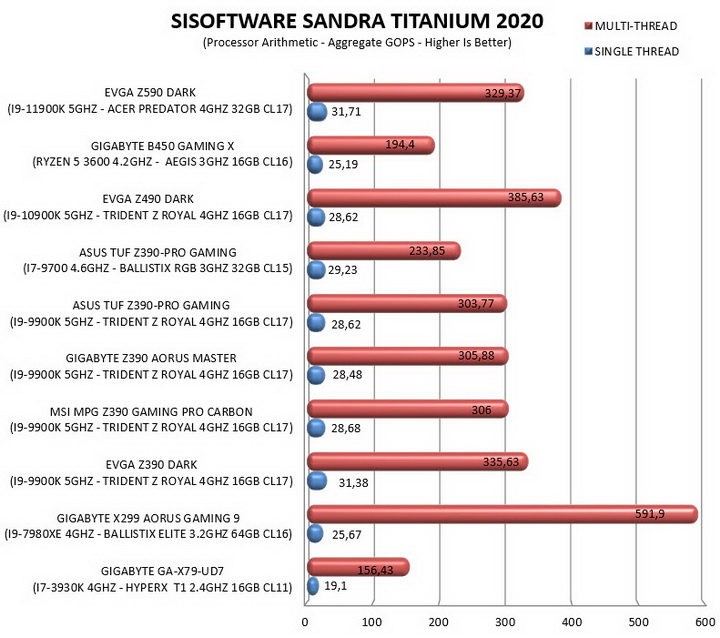
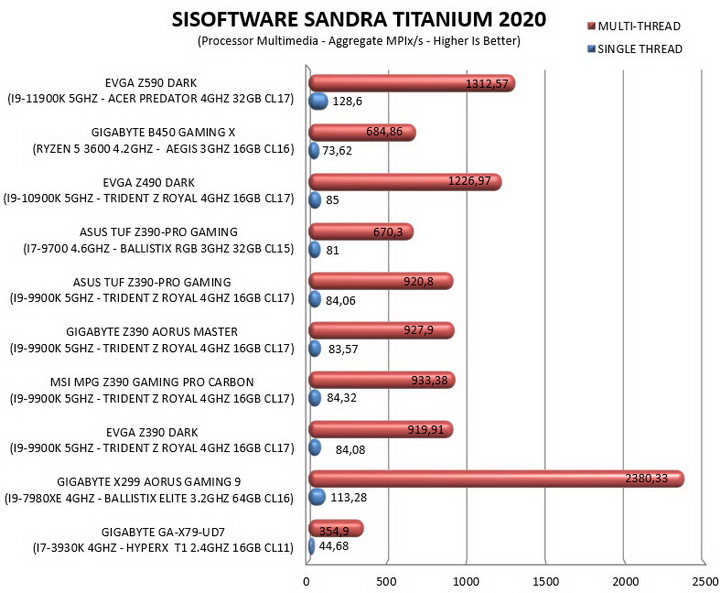
CONCLUSION
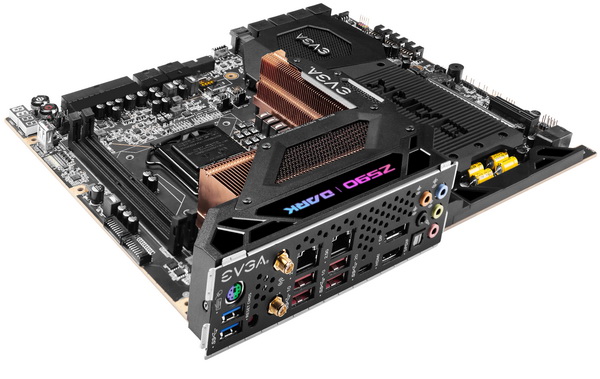
Judging by all the numbers in this review the Z590 may not be worlds apart compared to its predecessor but the performance gap between the Z490 and the Z590 is actually larger in many tests compared with that between the Z390 and the Z490. This is especially surprising when we take into account that the new Core I9-11900K CPU sports 8 cores compared to the 10 cores of the I9-10900K which I used for Z490 tests. Single core performance is obviously a lot better but even in multi-core scenarios the 11900K does very well against the 10900K. This of course also has a lot to do with the motherboard at hand and since the Z590 DARK by EVGA arrived here with 5 more Z590 models I can say that this is a more complete choice for my taste (especially when it comes to overclocking / 21-phase digital VRM, actively cooled at that), at least compared to the others I have here. Yes, I didn’t like the fact that EVGA decided to only equip it with 3 PCIe slots (2xPCIe 4.0 x16/x8 and 1xPCIe 3.0 x4) since many people including myself use multiple cards, nor did I like that it only comes with a single Gen 4x4 M.2 NVMe port (don’t know if it’s a chip limitation but for my job 2 would be best) but other than that this model has it all (and yes, it’s very easy to climb to 5.5GHz with this model, if temperatures are not an issue).
The DARK line of motherboards by EVGA has always been targeted towards overclockers and enthusiasts and so they are among the most expensive models in the market something which obviously applies for the Z590 model as well since it currently retails for USD549.99 inside the USA (Amazon.com) and for 579.84Euros inside the EU (Amazon.de). Of course, if you want the best there is then this is it, but if you are simply put not interested in overclocking at all then an EVGA model might not be the right one for you. For people however who are into overclocking (or people who just want the best) the Z590 DARK by EVGA sits at the top currently and for that it gets the Platinum Award.

PROS
- Build Quality
- OC Potential (Actively Cooled 21 Phase Digital VRM)
- 2 Reinforced & EMI Shielded PCIe 4.0 slots
- OC Features (PCIe Disable Switches / Slow Mode / Safe Boot / Triple BIOS / Dual Clear CMOS Buttons / USB BIOS Update Port)
- M.2 PCIe 4.0 Port
- DisplayPort v1.4 & HDMI v2.0 Video Outputs
- ARGB Lighting
- Available BIOS Settings
- NU Audio Amplifier
- U2 Port
- Angled Connectors
- Dual 2.5GbE Ports
- Bundle
- 3 Year Limited Warranty
CONS
- Price (For Some)
- Dual DIMM Design
- Only 3 PCIe Slots

 O-Sense
O-Sense





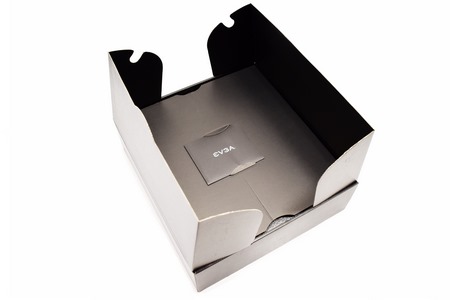
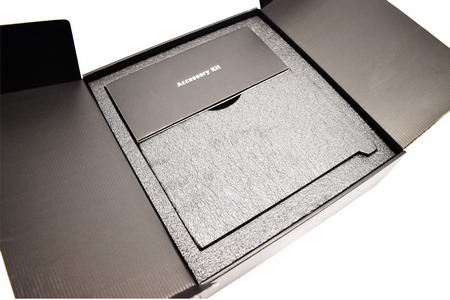
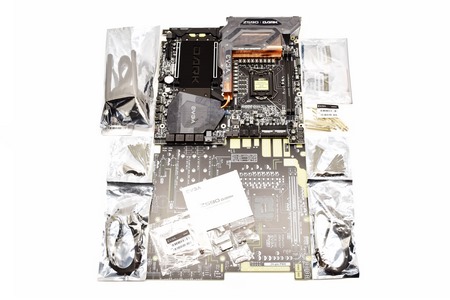
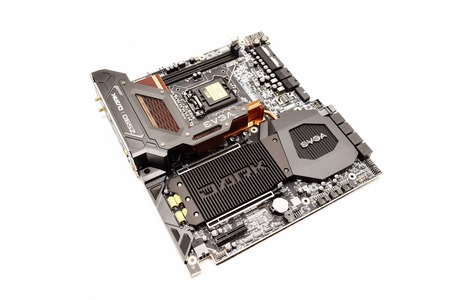
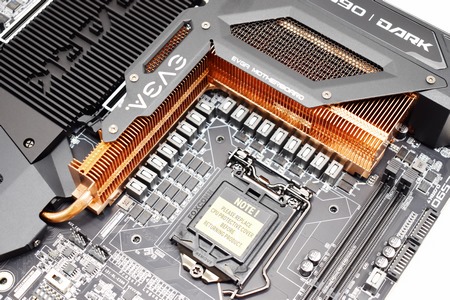
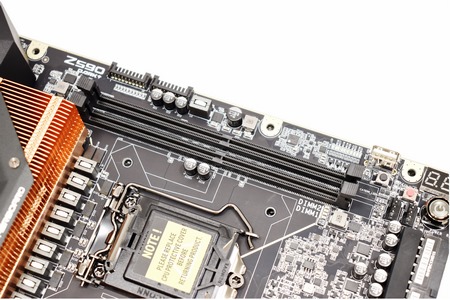
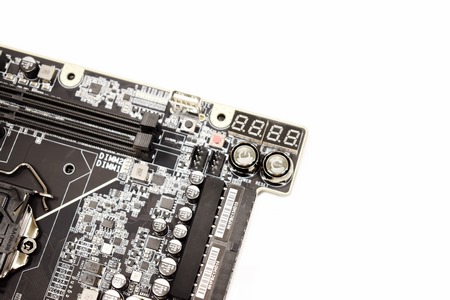
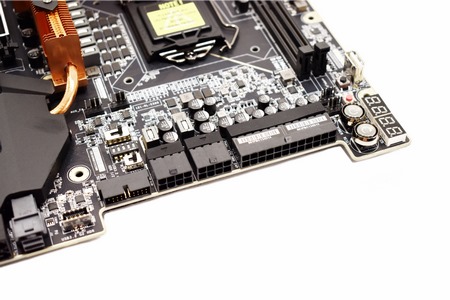
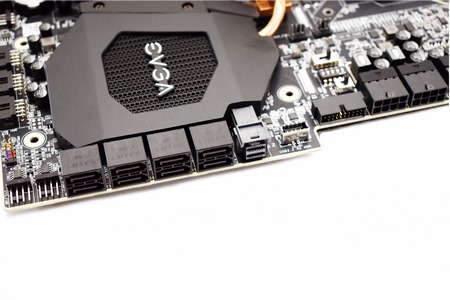
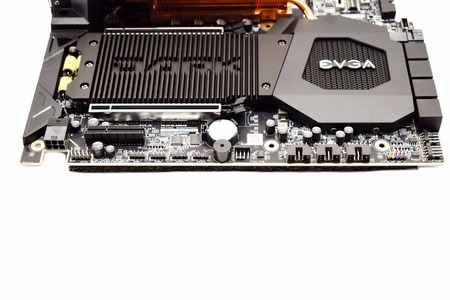
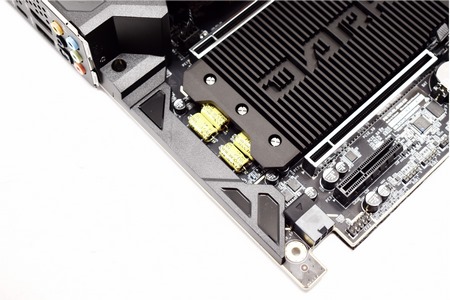
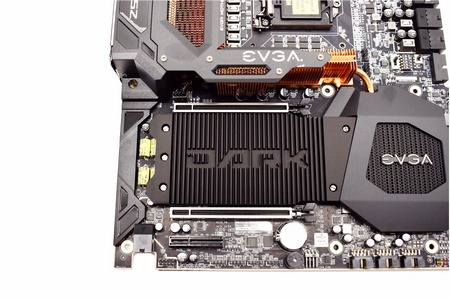
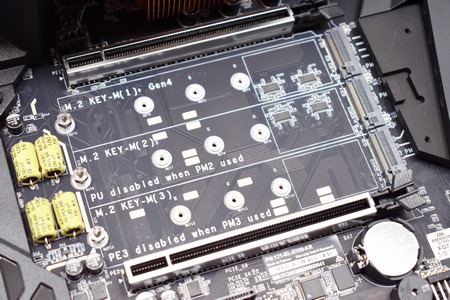
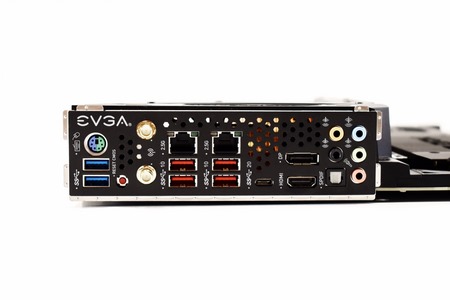
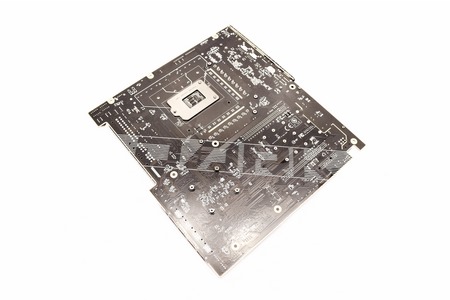
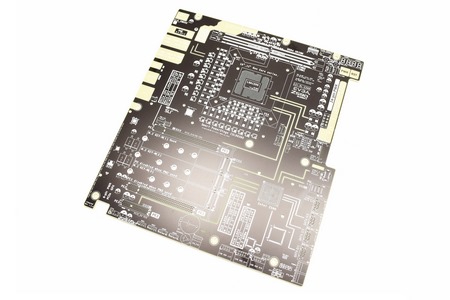
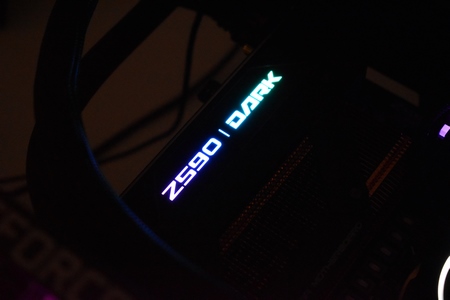
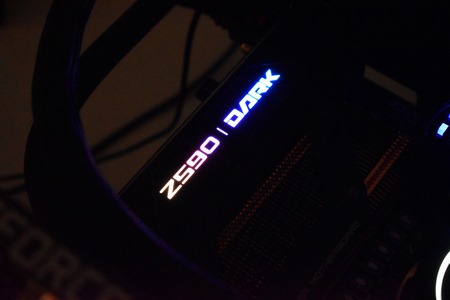
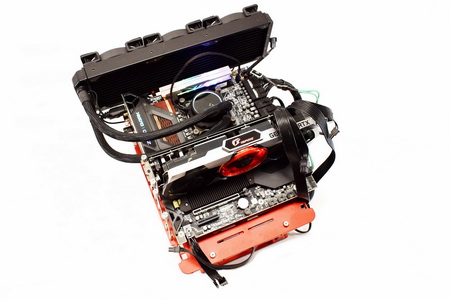
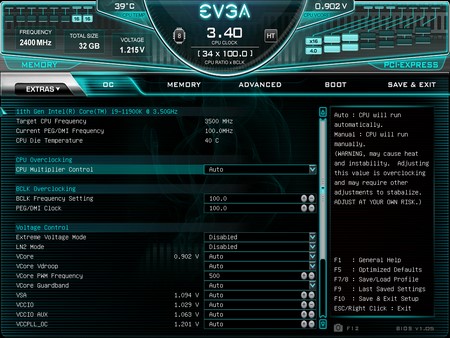
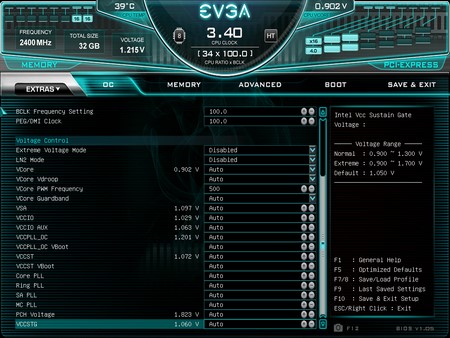
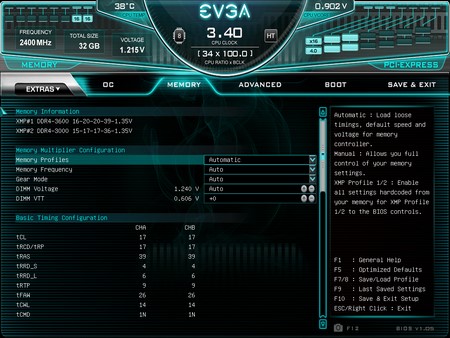
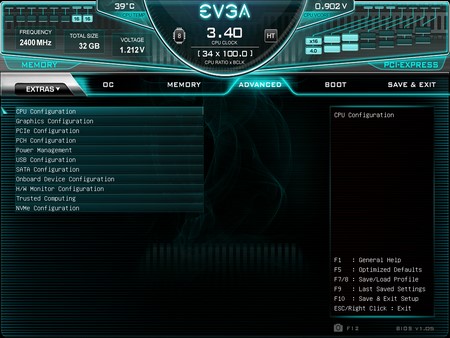
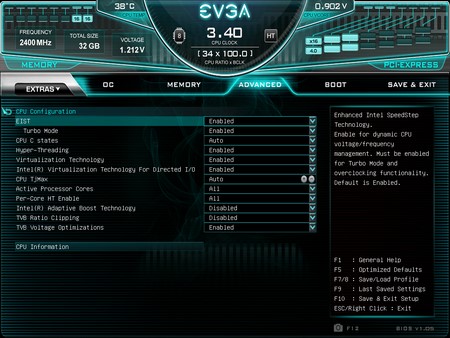
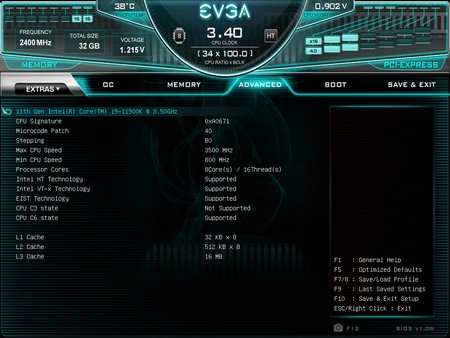
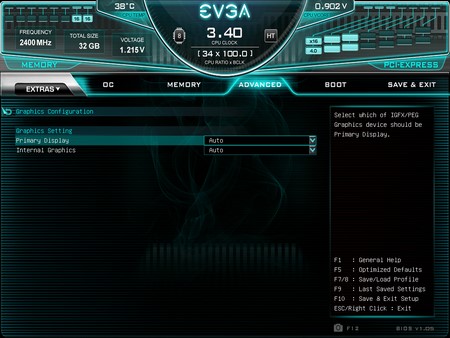
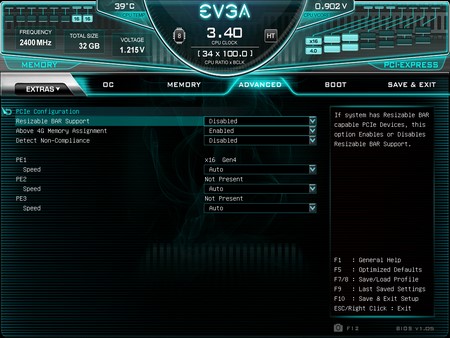
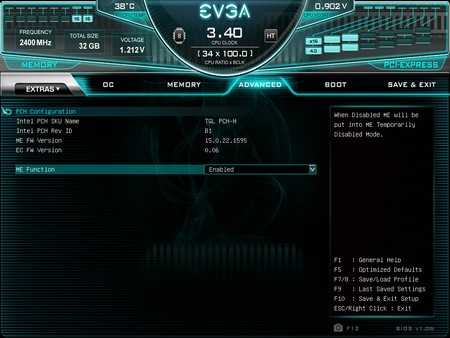
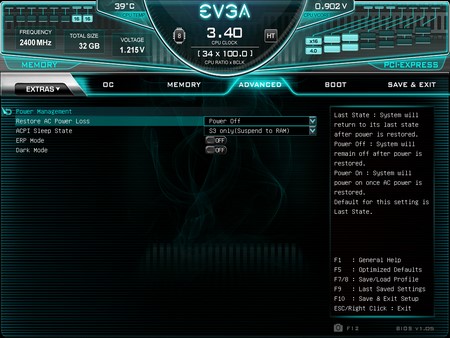
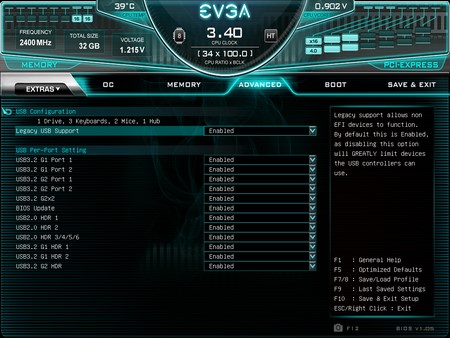
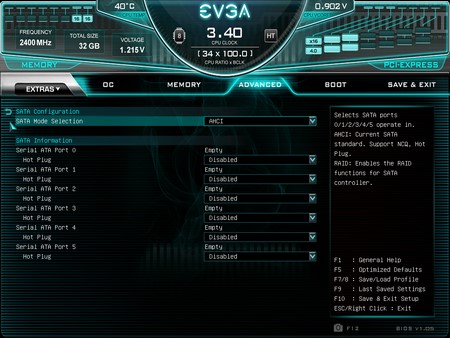
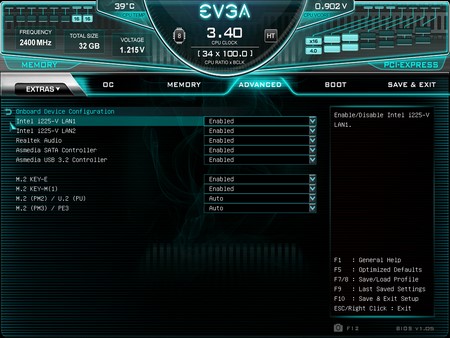
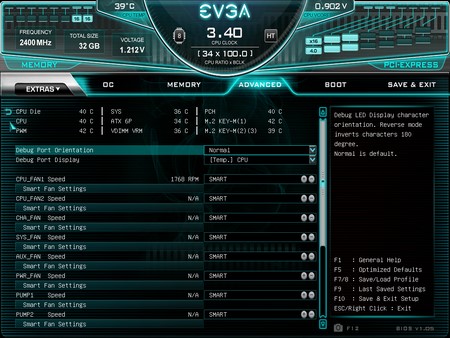
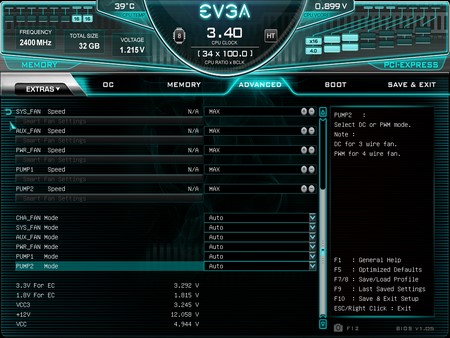
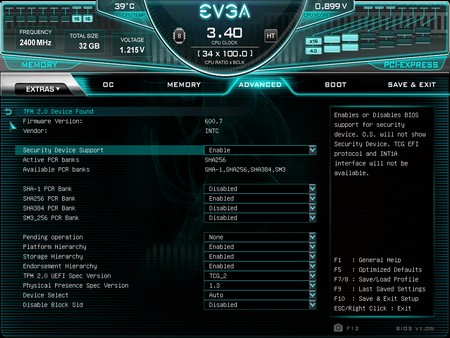
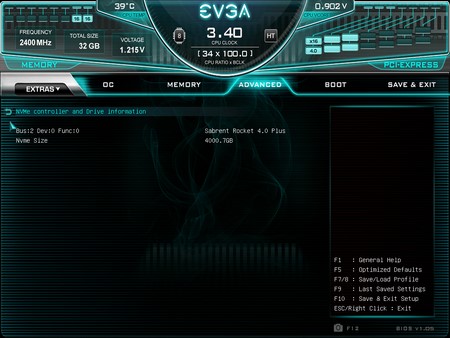
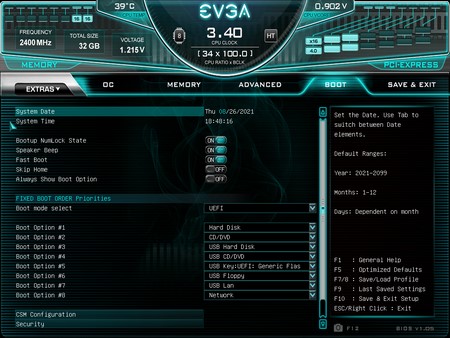
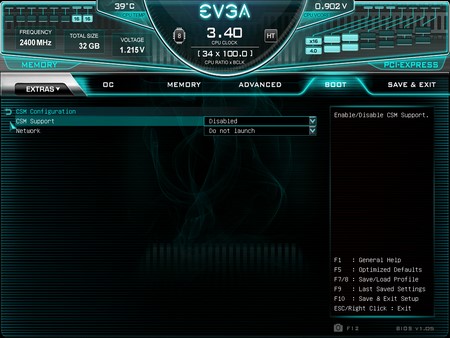
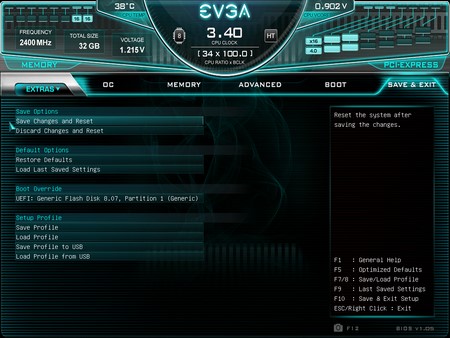
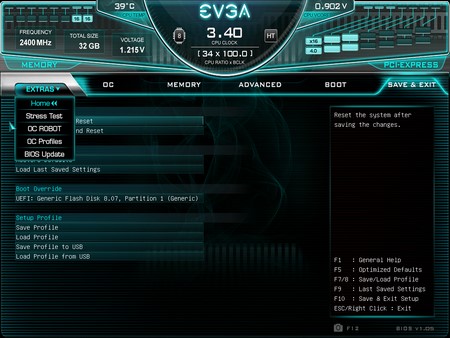
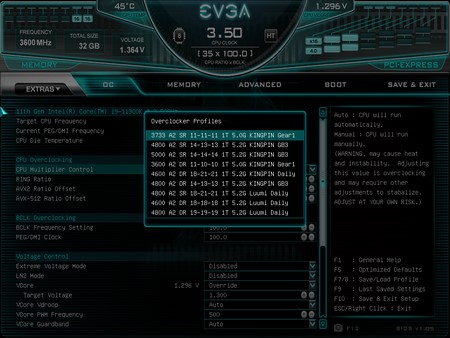
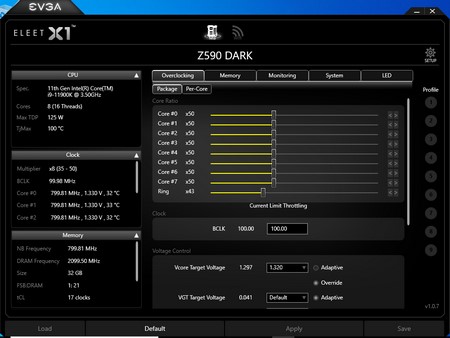
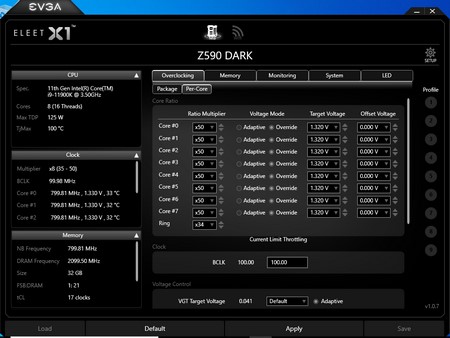
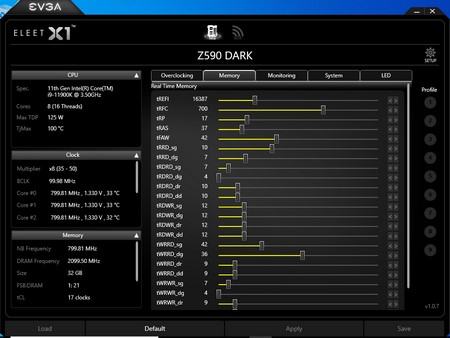
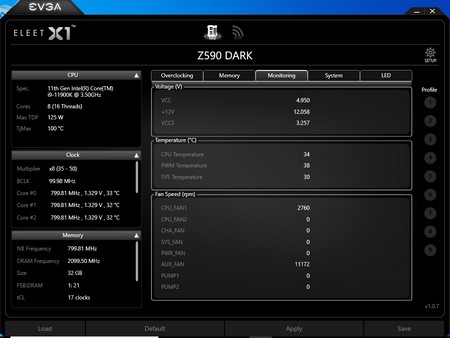
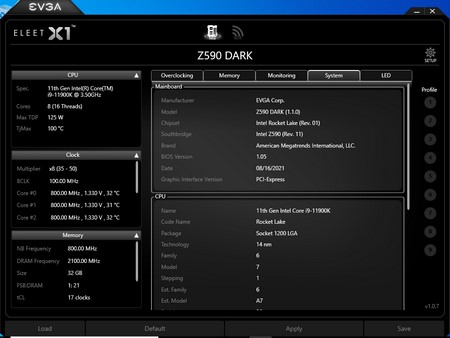
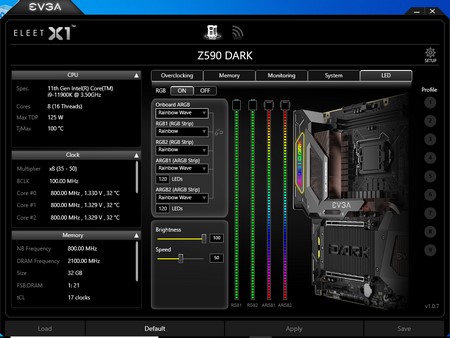
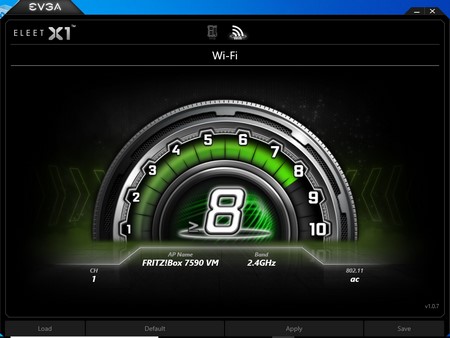


.png)

